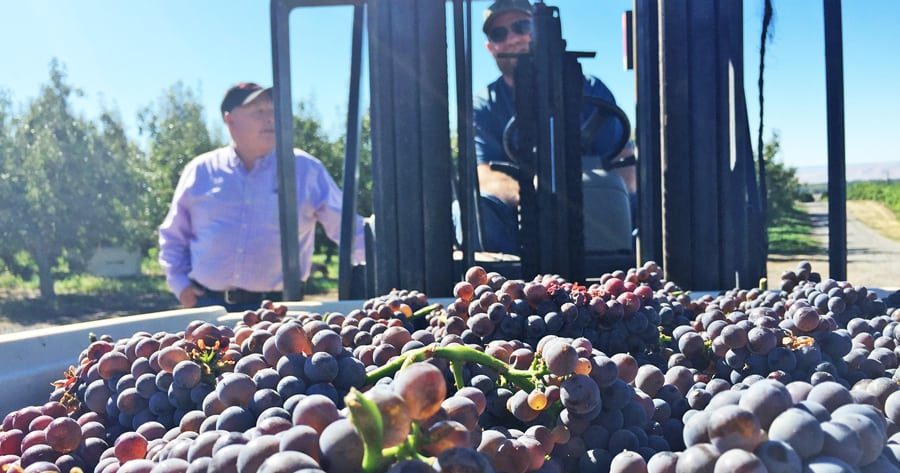
Home » Grape growers anticipating largest harvest in state history
Grape growers anticipating largest harvest in state history

November 15, 2016
By Wine News Service
Washington grape growers and winemakers are wrapping up what is being widely anticipated as the largest harvest in Washington history.
Pre-harvest estimates of a quarter-million tons of wine grapes are likely to be exceeded, as the crop has come in heavier than anticipated. Ste. Michelle Wine Estates, which uses two out of every three grapes grown in the state, reports that tonnage is coming in between 4 and 10 percent over its pre-harvest estimate.
“And we’re not done,” said Kevin Corliss, vice president of vineyards for Ste. Michelle. “We’re down to the last 10,000 tons or so. We’ll see where we end up.”
Washington’s biggest crop came in 2014, when 227,000 tons were brought in. If estimates for this year hold up, Washington’s wine industry will have doubled in a decade, as the state harvested 127,000 tons in 2007.
For several years, Washington has been the country’s second-largest wine-producing state, after California.
Mike Sauer, owner of famed Red Willow Vineyard in the western Yakima Valley, described “much bigger yields” because of heavier clusters.
“We always base our crop estimates on average cluster weights from past years,” he said. “You’d think your average numbers wouldn’t be off by too much in either direction. If it’s over or approaching being over, we do aggressive thinning. We thought we had a lot of blocks that we thought were right in the range, but the clusters were just heavier than we thought. We were 15 to 20 percent higher than average.”
But winemakers seem happy, even with the extra grapes.
“I’m pleased with the winery comments I’ve received so far,” Sauer said.
Rob Griffin, owner and winemaker for Barnard Griffin in Richland, called himself “grudgingly optimistic” about the quality.
“It’s tasting quite good,” he said. “I’m quite pleased.”
He, too, noticed the extra fruit arriving early on.
“People who have been doing this for years were off by 10 percent,” Griffin said. “Every time someone estimated 4 tons, we’d get 5.5.”
This has left a lot of wineries scrambling for fermenters and tank space.
“I dusted off some old bins we haven’t looked at in years,” Griffin said. “I have them all set up and ready to use. It’s nice to be ready. If I hadn’t had a little surplus capacity, I would have been in trouble.”
Griffin is wrapping up his 40th harvest in Washington. He arrived in 1977 as head winemaker for Preston Wine Cellars in Pasco. He launched his own winery in 1983 as a side project while heading up Hogue Cellars from 1984 to 1991.
Ste. Michelle’s myriad winemakers are so excited about the quality, they aren’t turning anything down, Corliss said.
“We’re shoehorning it in here and there,” he said. “Good fruit, good wine, trying to take advantage of it as much as we can. If they’re not completely full, they’re going to be.”
A lot of the extra fruit going to Ste. Michelle is coming from new Cabernet Sauvignon vineyards in the Horse Heaven Hills that came into production this year.
“They all did really well,” he said.
The biggest battle has been weather, as the normally arid Columbia Valley received 2.58 inches of rain in October, a record according to weather experts.
“That’s a lot for October,” Corliss said wearily. “It’s been a challenge. It rains, we wait for the wind to dry it out. We pick a little, then it rains, then we wait for the wind.”
Rick Small, owner of Woodward Canyon Winery in the Walla Walla Valley town of Lowden, finished picking in late October.
“It was a long harvest,” he said. “We needed the rain. We always want the rain. That’s good for us, recharging the water systems.”
He described the 2016 harvest as long and relatively uneventful, with no frost events to speak of in October. Like others, he noticed the grapes coming in a little heavier than anticipated, but he is pleased with the balance.
Sauer also mentioned the numbers on the grapes looked good, with sugars, acidity and pHs all being well balanced when they were delivered to his client wineries.
“The reports back from the wineries is they’re liking the quality,” Sauer said.
At this point, he’s putting away and fixing equipment. Harvest at Red Willow wrapped up Oct. 12.
“Things are wet and muddy,” he said. “We still have all the leaves on the vines, though they’re not too green anymore.”
Griffin said he believes the final number for the 2016 harvest could be 10 percent higher than anticipated.
“It got everybody,” he said. “It’s not anything that anyone could have predicted. It has to do with berry size and cluster weight.”
Final harvest numbers will likely be released in early to mid-February by the U.S. Department of Agriculture and the Washington State Wine Commission.
Local News
KEYWORDS november 2016




